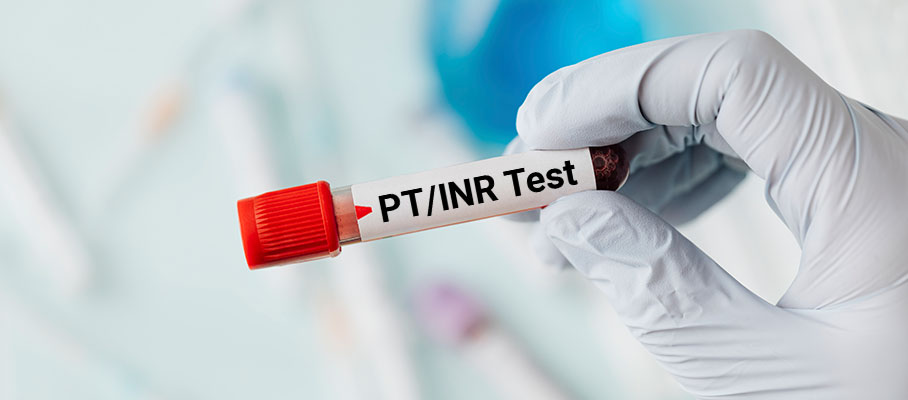Health Wellness
PT/INR Test (Prothrombin Time): Purpose, Precautions, Normal Range and Results

Table of Contents
- What is Prothrombin Time (PT/INR) Test?
- What Does a Prothrombin Time Test Detect?
- When Do You Need a Prothrombin Time Inr Test?
- What is The Purpose of The Prothrombin Time Test?
- How is the Prothrombin Test Performed?
- What are the precautions taken before taking Prothrombin Test?
- Are There Any Risks Associated with The Test?
- What Do the Results of The Prothrombin Time Test Mean?
What is Prothrombin Time (PT/INR) Test?
A Prothrombin Time (PT) test determines the time duration for clots to be formed in a blood sample.Time INR is a calculation done based on the results obtained from the PT test. The normal range of this test is 12-13 sec, which indicates a normal amount of clotting proteins in the blood
Prothrombin is a proteinaceous clotting factor produced in your body by the Liver. In case of injury or accidents, the clotting factors work together to form clots over the wound and prevent excessive blood loss. The rate of clot formation depends upon the number of clotting factors in your blood and how well they function.
Slow blood clotting in your body can lead to excessive blood loss during injuries. In contrast, too-fast blood clotting potentially results in harmful blood clots that can block blood supply through your arteries and veins.
The result of a PT/INR test determines the root cause of bleeding and clotting disorders. It also confirms whether the medications used to prevent blood clotting work correctly.
PT INR Test for Blood-Thinning
Besides its ability to detect the clotting tendency of blood, PT test can also be used to monitor patients who are being treated with the blood-thinners or anticoagulants.
Book a home sample collection for your PT test here.
Its importance has been further highlighted in the era of the COVID-19 pandemic. Various studies have established that PT is a strong indicator in predicting death rate in patients infected with COVID-19. Monitoring of PT in these patients can prevent thrombotic complications such as deep vein thrombosis (DVT), cardiovascular diseases (CVD) resulting from coagulation disorders.
What Does a Prothrombin Time Test Detect?
In case of an injury or cut, or injury to blood vessels, the body starts to immediately act and cells and platelets collect at the site of the wound. These cells try to slow down the bleeding by creating a temporary plug. Further, in order to produce a strong blood clot, a series of plasma proteins called clotting or coagulation factors act together to produce fibrin, which seals the wound and healing starts. Among these coagulation factors, prothrombin, also known as factor II, is vital to the clotting process.
Prothrombin time is an important test to detect whether five different blood clotting factors including factors I, II, V, VII, and X are present and working well together.
When Do You Need a Prothrombin Time Inr Test?
Your doctor can ask you to undergo PT, if you have following symptoms:
- If you bleed or bruise easily
- If you have blood in your urine
- If you develop unexplained blood clots
- If your gums bleed easily
- If you have unexplained heavy menstrual bleeding
- If you have unexplained nosebleeds
- If you develop frequent swelling or pain in your joints.
Your healthcare provider can also tell you to take this test regularly, if you are taking the blood-thinning medication or warfarin, so as to confirm that you’re not taking too much medication which can cause excessive bleeding.
What is The Purpose of The Prothrombin Time Test?
The test can be used to diagnose inherited disorders and other conditions influencing blood clotting, including:
- Vitamin K deficiency
- Deficiency in clotting factor I, II, V, VII, or X
- Diseases of the liver
- Hemophilia
- Diseases involving bone marrow
- Von Willebrand disease
- Diseases with immune system
- Cancer, including leukemia.
How is the Prothrombin Test Performed?
Prothrombin time test usually takes less than five minutes and is done by taking a blood sample from your vein. A needle is inserted into the vein of your arm, and a small amount of blood will be collected into a test tube or vial. You may experience a little sting when the needle goes in or out.
What are the precautions taken before taking Prothrombin Test?
You do not need any preparation before preparing for this test, as you are not needed to fast before a PT.
However, certain food items such as liver, broccoli, chickpeas, green tea, kale, turnip greens, and foods made from soy might affect your results. Consult your doctor for more clarity.
Moreover, few medicines that help prevent blood clots can also affect your test results, which include:
- Warfarin
- Aspirin
- Heparin
- Other blood thinners like direct thrombin inhibitors and factor Xa inhibitors.
Other medicines such as steroids, antibiotics, estrogen medicines, antacids, nutritional supplements can also affect your lab results.
Caution:
Do not reduce the dose or stop any medication without consulting your healthcare provider.
Are There Any Risks Associated with The Test?
There is very little risk associated with PT. Some people may experience mild symptoms, most of which disappear quickly. Some of them are:
- Feeling dizzy or lightheaded
- Bleeding or bruising at the site of puncture
- Infection.
However, if you have a bleeding disorder, you might be at increased risk for excessive bleeding and hematoma.
What Do the Results of The Prothrombin Time Test Mean?
Prothrombin time test results can alter according to your age, gender, medical history, and the method used for the time test.
If you are not taking any blood-thinning medicines
PT INR normal range between 11 and 13.5 seconds. The results of PT are generally reported as an prothrombin time INR and normal range for a person is 0.9 to about 1.1.
If your INR or PT results were not normal, it signifies following conditions:
- A bleeding disorder
- A clotting disorder
- Liver disease
- Vitamin K deficiency.
If you are taking blood-thinning medication or warfarin
INR is usually between 2 and 3.5 as blood thinner increases the clotting time.
- If INR levels are high, it indicates risk for dangerous bleeding.
- If INR levels are low, it indicates the risk for dangerous blood clots.
To Summarize
Prothrombin time test is a crucial test to diagnose clotting time of blood plasma. It has gained a lot of importance in the current COVID-19 scenario as the majority of these patients are at risk of abnormal coagulation/clotting. Several studies have validated that abnormal levels of PT is associated with worsening of illness and ultimately death. Therefore, performing PT in these patients can diagnose the problems associated with clotting and prevent further complications like DVT and CVD.




































